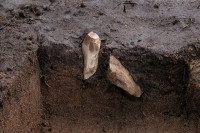
The biggest archaeological excavation in Norway ever
is now finished. This excavation would never been started if there were
not plans for carrying out the second biggest single industrial project
in Norway.
Photo.
Field-supervisor Torkel Johansen digs
at one of the many sites in the
area.
Through the mist in the background it's possible
to catch a glimpse of the construction-machinery. Photo
copyright: The Museum of Natural
History and Archaeology (Vitenskapsmuseet), Norway.
In connection
with the construction of an onshore gas processing plant at Nyhamna on the
island of
Gossen in Møre
and Romsdal
County, NTNU and
the Museum of
Natural
History and Archaeology in
Trondheim, have
recently carried out an archaeological excavation on a series of protected
cultural heritage sites.
According to the
Museum of Natural History and Archaeology (Vitenskapsmuseet), Trondheim in
Norway on its website (www.vitenskapsmuseet.no/ormen), Møre and
Romsdal County's cultural protection section carried out comprehensive surveying
and located more than 60 automatically protected cultural heritage sites during
2001 and 2002 in the North-eastern part of the island.
|
Photo.
The young boy Michael Hukkelberg from
Riksfjord
School found many interesting objects. It was
great for him to get experience as an archaeologist on the Ormen Lange
project at Nyhamna. Copyright: Museum of Natural History and Archaeology
(Vitenskapsmuseet), Norway. |
 |
It's assumed
that totally 34 large and small sites will be directly affected by construction
activity. The Directorate for Cultural Heritage (Riksantikvaren) has granted
dispensation from the country's cultural heritage laws that prohibit
interference of such sites. One of the conditions of the dispensation is that
NTNU and the Museum of
Natural
History and Archaeology
excavate the affected sites that in age range from the Early Stone-age to the
Late Iron-age.
|
Photo. Two flake-axes.
Copyright:
Museum of Natural History and Archaeology (Vitenskapsmuseet),
Norway.
|
 |
The excavations
in Nyhamna began on 14th May 2003. The official
opening of the construction of the gas-terminal at Nyhamna took place on the
16th April. The mayor of Aukra
County council,
Aud Mork was given the hono
ur of turning "the first sod". A field-laboratory
was set up to take care of the large number of finds.
More than 60
archaeologists have worked at Nyhamna at the busiest time.
The interest for
the archaeological excavation has been big. On Thursday 25th March, the Museum
of Natural History and Archaeology and Møre and Romsdal County Council organised
an open-day at Nyhamna. Around 700 people came to Nyhamna to see the
archaeological site that day. The Museum informed about the archaeological
excavations, whilst the Council showed people around the old whaling-station.
This was the last opportunity for the residents of Aukra and the counties around
to visit the excavations before the start of construction work by Norsk Hydro.
This article continue in Part 2:
read more about archaeological exaction, finds and revealing of the past. What
are the finds, and what new have these finds brought to the Norwegian
history?
Stein Morten Lund,
17 August
2004
Additional
information
For more
information, read about the excavation on the
Museum of
Natural
History and Archaeology's
(Vitenskapsmuseet) website www.vitenskapsmuseet.no/ormen
(here you find an English version too).
It's also possible to view pictures of a selection of the finds from the
excavations at Nyhamna and other places. You can find links here to other
excavations in Norway too.
The Norwegian
Directorate for Cultural Heritage (Riksantikvaren - www.riksantikvaren.no/english):
Protection under
Cultural Heritage Act: The purpose of cultural heritage management is described
in the Cultural Heritage Act, which lays down that it is a national
responsibility to safeguard archaeological and architectural monuments and sites
and cultural environments "as part of our cultural heritage and identity and as
an element in the overall environment and resource management". Riksantikvaren
(in Norwegian language - main site): www.ra.no
The UNESCO World
Heritage List contains areas or objects that are an irreplaceable part of the
world's cultural or natural heritage. The World Heritage Convention adopted as
its aim in 1972 to give special protection to places that because of their
universal value must be regarded as part of the world heritage for future
generations.
Norway
ratified the convention in 1977, and has the following four sites on the list:
- The
Mining
Town of Røros
- Bryggen in
Bergen
- The Rock
Carvings at Alta
-
Urnes
Stave Church
Norway member of the UNESCO Committee:
Norway has
been elected as a member of the World Heritage Committee. The Convention
Concerning the Protection of the World Cultural and Natural Heritage (the World
Heritage Convention) was adopted by the General Conference of UNESCO in 1972. To
date, more than 170 countries have adhered to the Convention. Nils Marstein,
Director General of the Norwegian Directorate for Cultural Heritage since 1995,
will represent Norway in
the Committee.
The Ormen
Lange project:
orsk Hydros
subsea solutions are taking technological developments on
the Norwegian continental shelf a significant step ahead. Nothing will be
visible on the surface when the enormous gas field Ormen
Lange comes onstream in 2007. The field will be developed with seabed
installations at depths of between 800 and 1100 metres, and will be linked to a
processing plant on land at Nyhamna in Aukra municipality, from where the gas
will be exported. When it reaches full production, the field will meet 20
percent of the UK demand
for gas.
The Ormen Lange
field is located in the Norwegian
Sea, 100 kilometres
north
west of the coast of
Møre,
Mid-Norway. It is Norway's
largest gas field, and was proven through drilling by Norsk Hydro in 1997. At
most there will be up to 2,500 people involved in the development of the
processing plant. This is twice the population of Gossen, in the
municipality of
Aukra. For more
information click on the link: www.ormenlange.com/en
